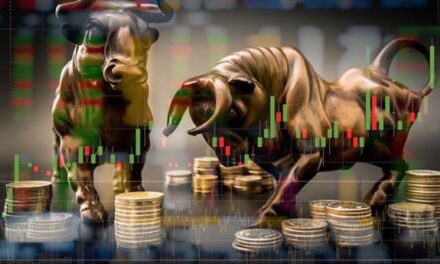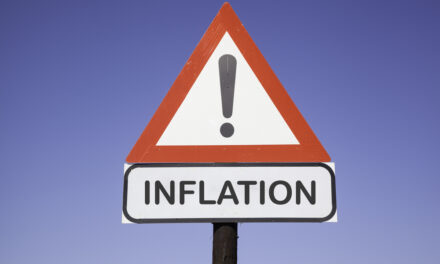“Why aren’t the stocks you told me to buy going up?”
It’s one of the top questions any financial newsletter writer gets.
Another: “Why did the stock that went up so much come back down again?”
This is understandable. We all invest to make money, not to lose it. Besides, behavioral economics shows that we experience losses more strongly than missed gains.
Being a financial writer involves more than just picking stocks. It’s also my job to give you the tools and information you need to be smart and tough about your investing.
And the most important thing every investor must learn … as soon as possible in their investing career … is that stocks don’t go up in a straight line.
Today, I’m going to show you the data that proves why this is indeed lesson No. 1.
The Rocky Road to Profit
Here’s a chart that shows the monthly average daily closing price of the U.S. stock market going back to 1871. It also shows the percentage gain since the previous low, and the percentage loss since the previous high:

(Click here to view larger image.)
Here are the key takeaways from this chart:
- The stock market goes up over time, but not in a straight line. It’s punctuated by alternating “secular” bull and bear markets — secular meaning long-term trends over years or decades.
- Most of the time, secular bull markets last longer than secular bear markets, and their gains exceed the latter’s losses.
- Critically, even within secular bull markets, the stock market experiences frequent pullbacks. For example, here’s a detailed chart of the decade from 1992 to 2000:

(Click here to view larger image.)
Knowing When to Hold and Fold
This chart combines secular bull and bear markets with big pullbacks within the former:

(Click here to view larger image.)
I’ve circled a couple of key points in this progression. Each one represents a big pullback within a longer secular bull market.
The first shows a 20% pullback in 1956. Many investors panicked and sold. They lost out on the gains into the beginning of the 1970s.
The second circle shows Black Monday in 1987 when the market dropped roughly 30% … only to continue its upward march until the dot-com bust.
The final circle is the 20% coronavirus plunge in March last year.
In each of these pullbacks, some investors panicked and sold, and some saw it as an opportunity to buy at great prices.
Those who bought the dip follow the script that has been creating fortunes in the stock market for more than a century.
A Predictable — and Profitable — Pattern
This bird’s-eye view of stock market behavior suggests that we are right in the middle of a secular bull market … and only about halfway to its ultimate gains.
During the 1920s, the stock market rose by over 450%, trough to peak.
The postwar bull market saw stock prices rise by over 650%.
The secular bull run from 1982 to 2000 saw gains of over 800%.
The pattern is clear. Each new secular bull market leads to bigger gains than its predecessors.
And the chart above shows that about halfway through these bull markets, there is a shakeout that prompts weak hands to sell their stocks to savvier investors.
But here’s the thing: The stock market has only risen about 400% since its bottom in early 2009. Even if we just match the last secular bull market, we’re only halfway there.
And given the regular progression in the size of secular gains, the bulk of this bull market’s gains remain in front of us!
The FOMO Effect
Indeed, the pattern for most secular bull markets is that the second half sees gains come much faster than the first half. That comes down to the FOMO effect.
FOMO stands for “fear of missing out.” It happens when people who are making money in the stock market start to brag about those gains, prompting others to want to join in.
But the speed and scale of FOMO’s impact on the market depends on technology.
In the 1920s, people learned about stock market gains by word-of-mouth. In the 1950s, they learned about opportunities via radio, television and telephone. By the 1990s, we had bespoke financial TV channels reporting on the stock market 24/7.
Each time, FOMO spread wider and faster. This time, however, we’ve got the fastest FOMO freeway of all — social media.
Starting just after the shakeout in March last year, investors began to swarm social media with ideas about stocks. One Reddit channel, WallStreetBets, has become so influential that it’s now shorthand for retail investors.
Of course, there’s one other big difference this time around. In the 1990s, the last secular bull market, people had to trade using brokers and pay commissions. These days, all you need to do is flick open a smartphone app.
For Future Profit, Understand the Past
Putting this all together tells us that we are poised for an even faster rise in stock levels over the next decade than the one we’ve just enjoyed.
We’ve had the typical mid-bull market shakeout already. (We’re experiencing a mini shakeout in growth stocks right now.)
So put aside concerns over short-term dips in individual stock holdings. Those stocks aren’t going to go up in a straight line (and of course, not all of them will be winners).
But history tells us that investors who stay smart and tough are poised for the biggest gains they’ll ever see!
Kind regards,

Ted Bauman
Editor, The Bauman Letter









